A histological analysis of SARS will be developed to clarify the main signs and symptoms of the disease, its epidemiology and etiology, the histological changes, and the existing treatments. SARS stands for severe acute respiratory syndrome. It is a viral respiratory disease that is usually caused by the presence of a coronavirus, known as an SARS-associated coronavirus, in a human organism (Centers for Disease Control and Prevention, 2013). Its fatality rate is approximately 10% (Van den Brand, Haagmans, van Riel, Osterhaus, & Kuiken, 2014).
Clinical Signs and Symptoms
Many people are not able to recognize SARS in its first stages because of its flu-like symptoms and signs. People may suffer from chills, pain in muscles, and possible diarrhea. Diarrhea is explained by the active viral replication that occurs in entrecote and disrupts the intestinal architecture (Van den Brand et al., 2014). Such symptoms as a fever up to 380C, dry cough, and even shortness of breath are observed. In some cases, people with the SARS-associated coronavirus in their systems may have malaise, vomiting, and headache (Hui, Memish, & Zumla, 2014). All these signs could be observed among patients with different diseases.
Certain laboratory tests and radiological features have to be taken into consideration. Besides, people have to be careful with such risk factors as recent travels to the exotic or Asian countries, diabetes, smoking, heart diseases, and even hypertension (Doherty, 2013). Clinical and laboratory data on SARS is limited, and people continue developing the methods to recognize the disease under analysis. Therefore, SARS patients and their families are still under a threat of being maltreated or mistakenly diagnosed even in the hospitals with a good reputation.
Epidemiology
Adults are usually under a greater threat of having SARS in comparison to children (Hui et al., 2014). As for the gender factor, 57% of females and 43% of males are recorded as those who have SARS. Most cases of SARS were observed in young adults. Taking into consideration these criteria and risk factors, it is possible to say that smoking females between 25 and 35 years introduce a group of people that could be highly affected by the SARS-associated coronavirus and even die because of the development of this disease in their organisms.
According to the information given by the World Health Organization, the citizens of China and Hong Kong should be worried about the outcomes of the SARS epidemic (Van den Brand et al., 2014). In November 2002, the first recognized SARS epidemic was observed in the Guangdong Province with more than 1000 patients delivered to the hospital with several pneumonia signs. The laboratory results identified the presence of the SARS-CoV despite a number of positive antibodies to that virus. 55 people died during the first epidemic of SARS. The second outbreak of the epidemic was observed in Hong Kong. During that epidemic, 30 people died because of SARS. In several years, in Canada, 10 people died in the SARS epidemic.
The first steps which representatives of the infection control organizations had to take were the necessity to remove communication and any other form of contact between the diseased and healthy people. People-to-people transmission of the virus was a serious discovery that could not be neglected.
Etiology
The spreading of the disease among different countries in a short period of time tells about the necessity to investigate the etiology and the causes of SARS. The main cause of the SARS epidemic in any country is the already identified SARS-associated coronavirus also spelled as SARS-CoV. It is an RNA-type virus with certain peripheral corona-like outgrowth (Van den Brand et al., 2014). Unfortunately, the nature of the transmission of the virus between people was not completely understood. Still, it is believed that, in most cases, the virus could be delivered through water droplets which occur during coughing or sneezing. Therefore, if people want to reduce the possibility level of getting SARS, they have to keep their distance from the affected groups of people. Hand hygiene, masks, and even eye protection means could be defined as good contributors to the protection against SARS.
People could take molecular tests and serological tests to identify the presence or prove the absence of the SARS-CoV in an organism. The determination of cytokines in plasma is one of the first stages of lab analyses (Van den Brand et al., 2014). Blood tests and the analysis of cell culture should also help in identifying the virus and the development of the disease that could lead to death.
Affected Systems
Despite too general signs and frequent causes of the disease, it may have a crucial impact on the work of different systems in the human body. The SARS-CoV may influence the immune system because of the necessity of immune and inflammatory cells to work hard and deal with the lesions caused by the SARS infection (Van den Brand et al., 2014). The central nervous system is under threat as well because of the pathology and possible degeneration of neurons in the human brain. The SARS-CoV may cause kidney problems. Therefore, the urinary tract infection cannot be neglected. Such sign as diarrhea is the reason to worry about the work of the gastrointestinal tract. Centrilobular necrosis influences the work of livers as well. Finally, necrosis of skeletal muscle and the changes in tissue should be taken into consideration.
Again, it is necessary to underline that not all aspects of the SARS epidemic have been identified and investigated. It could happen that other systems may be affected by the presence of the virus. The genomic sequences of the SARS-CoV cannot be detected using the cases available. Besides, the responses of the systems could depend on the age of a patient.
Histological Appearance Changes
Regarding the histology of a normal lung, all sections of lung tissue may be compared with a fine lace because of thin-walled alveoli as the main composition of a human lung. Bronchioles and alveoli are the main lung components through which the exchange of air occurs. There is a single layer of squamous epithelium in alveoli. In Figure A, it is also possible to observe a thin layer of connective tissue between the alveoli. Besides, there are many capillaries. In Figure A, there are several bronchioles, which are characterized by different size. In comparison to capillaries which are lined with the squamous epithelium, bronchioles are lined with other types of epithelium, known as columnar and cuboidal.
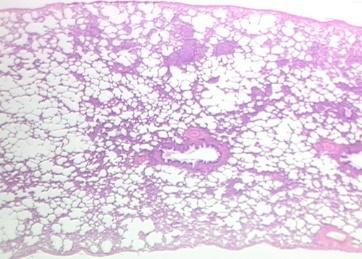
Histopathologically, the changes in the respiratory tract are usually characterized by diffuse alveolar damage (DAD) as a form of pulmonary injury that is inherent to many SARS patients because of the existing immunopathogenetic factors (Gu & Korteweg, 2007). In Figure B, it is possible to observe severe damaged caused by lung tissue. These changes lead to the formation of a hyaline membrane, edema, and fibrin exudation (Gu & Korteweg, 2007). In Figure C, the changes in lungs and the creation of the multinucleated cells (marked by arrows) are introduced. Figure D demonstrates the development of viral genomic sequence and the combination in situ hybridization with antibodies. The first arrow in Figure D represents an infected cell known as pneumocytes. The second arrow in the same figure represents an inflammatory cell with SARS virus (Gu & Korteweg, 2007). The third arrow shows a cell without a virus. Figure E demonstrates different sequences of SARS-CoV in cells. The first arrow is the infection of T lymphocytes, the second arrow is an uninfected CD3-positive cell, the third arrow is an ISH-positive cell, the fourth arrow is a pneumocyte with a positive ISH, and the fifth arrow is an ISH-positive vascular endothelial cell. Figure F shows how spleen tissue changes lymphocytes. Finally, Figure G shows how ISH signals define patient’s brain tissue (Gu & Korteweg, 2007).
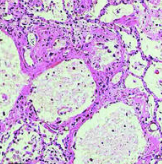
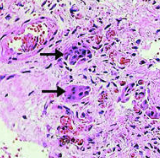
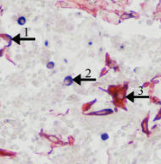
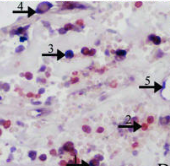
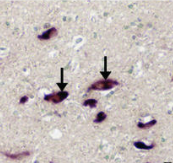
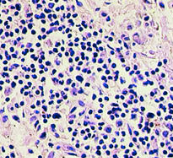
Current Treatments
The incubation period for patients with SARS can last from 2 up to 10 days. The isolation of patients should occur in a short period of time. It is suggested to use negative pressure rooms so that even nurses may avoid direct contact with patients. Radiography helps to find out the measurements of the respiratory phase when the patients may or may not be dangerous for other people around. Current chiropractic treatment for SARS patients that is characterized by the absence of any surgeries for improving work of the system includes antibiotics such as amoxicillin or clarithromycin and glucocorticoid, which help to control cytokine responses, which are caused by SARS-CoV. The promotion of intensive care treatment in the form of aerodynamic ventilation is also required (Van den Brand et al., 2014). Finally, antiviral therapy should be offered as a general method of treatment for people, whose changes in the organism are caused by the presence of a virus.
Interest in the Topic
There are several reasons for why the SARS epidemic is chosen for the analysis. People know about the existence of this disease and learn how dangerous it could be for people regarding their gender and age factors. Besides, the location of people may contribute the development of the disease. In case one person gets SARS-CoV, there is a threat that more people, who are or were in close contact with a patient, could get the same health problem. Still, not many investigations could be found on the chosen topic. Even the experts could fail to diagnose the disease in time. People die horribly because of SARS, and researchers could say a little about the case (Doherty, 2013). As a chiropractor, I am interested in SARS because this disease may cause myopathic and neuropathic complications which are hard to detect and treat in a chiropractic clinic. New methods of treatment have to be investigated soon to be ready to help people with different phases of SARS. At this time, the only way that could be used to support infected patients is the provision of an incubation place for treatment and the experiences with an anti-viral therapy based on well-known antibiotics.
Conclusion
In general, the analysis of the SARS epidemic developed in this paper helps to clarify the weaknesses of research done on the topic and underline the major facts people have to be aware of. It is easy to get the virus, and it is hard to get rid of it without certain losses.
References
Centers for Disease Control and Prevention. (2013). About severe acute respiratory syndrome (SARS). Web.
Doherty, P.C. (2013). Pandemics: What everyone needs to know. New York, NY: OUP USA.
Gu, J., & Korteweg, C. (2007). Pathology and pathogenesis of severe acute respiratory syndrome. The American Journal of Pathology, 170(4), 1136-1147.
Hui, D. S., Memish, Z. A., & Zumla, A. (2014). Severe acute respiratory syndrome vs. the Middle East respiratory syndrome. Current Opinion in Pulmonary Medicine, 20(3), 233-241.
Van den Brand, J. M. A., Haagmans, B. L., van Riel, D., Osterhaus, A. D. M. E., & Kuiken, T. (2014). The pathology and pathogenesis of experimental severe acute respiratory syndrome and influenza in animal models. Journal of Comparative Pathology, 151(1), 83-112.